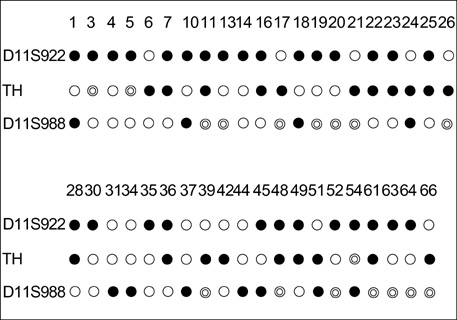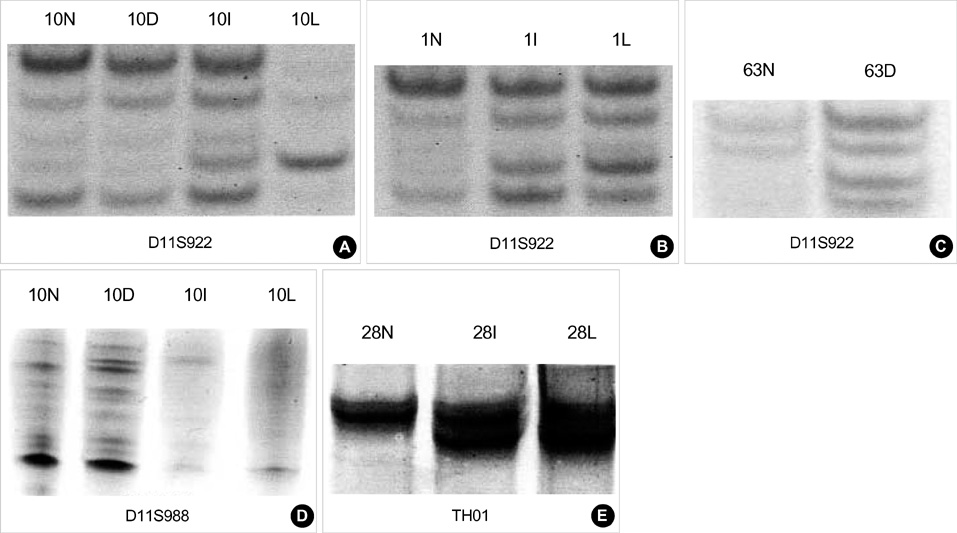J Korean Med Sci.
2004 Oct;19(5):698-703. 10.3346/jkms.2004.19.5.698.
The Role of Microsatellite Instability at Chromosome 11p15.5 in the Progression of Breast Ductal Carcinoma
- Affiliations
-
- 1Department of Pathology, Fatima Hospital, Daegu, Korea. dongja@fatima.or.kr
- 2Department of Pathology, Samsung Cheil Hospital, Sungkyunkwan University School of Medicine, Seoul, Korea.
- 3Department of Pathology, Kyungpook National University School of Medicine, Daegu, Korea.
- KMID: 1733512
- DOI: http://doi.org/10.3346/jkms.2004.19.5.698
Abstract
- The study of microsatellite instability (MSI) has provided the evidence to support asequential, progressive pathway for the development of cancer. In this study, we analyzed the role of MSI at chromosome 11p15.5 using microdissection of paraffin-embedded tissue from 68 matched normal and breast tumor samples. Components of intraductal, invasive and metastatic foci in lymph node were assessed for MSI using the polymorphic markers D11S922, tyrosine hydroxylase (TH) and D11S988. We found that MSI at D11S922 was relatively high incidence than other two markers and increased during breast cancer progression. The overall frequency of MSI at D11S922 was 26.7% in pure intraductal carcinoma, 36.4% in invasive carcinoma, and 40.0% in invasive carcinoma with metastases. We observed no significant correlation between MSI at chromosome 11p15.5 and the patient's age, tumor size, histological grade, or lymph node metastasis. We compared the MSI incidence with the expression of prognostic markers, such as p53, c-erb B2, estrogen receptor, and progesterone receptor, and found no significant correlation. We suggest that the MSI of chromosome 11p15.5 is increased during breast cancer progression, but long-term follow-up study would establish whether MSI at chromosome 11p15.5 could be useful as a potential prognostic marker for breast cancer.
Keyword
MeSH Terms
-
Breast Neoplasms/*genetics/metabolism/pathology
Carcinoma, Ductal, Breast/*genetics/metabolism/pathology
Carcinoma, Intraductal, Noninfiltrating/*genetics/metabolism/pathology
*Chromosomes, Human, Pair 11
Female
Humans
Immunohistochemistry
Microsatellite Repeats
Prognosis
Protein p53/metabolism
Receptor, erbB-2/metabolism
Receptors, Estrogen/metabolism
Receptors, Progesterone/metabolism
Figure
Cited by 1 articles
-
Microsatellite Instability in Invasive Ductal Carcinomas
Duck Hyoun Jeong, Jin Cheol Jeong, Chan Heun Park, Mi Jung Kwon, Seong Jin Cho, Eun Sook Nam, Hyung Sik Shin, Kwan Seok Kim
J Breast Cancer. 2007;10(1):77-84. doi: 10.4048/jbc.2007.10.1.77.
Reference
-
1. Parker SL, Tong T, Bolden S, Wingo PA. Cancer statistics. CA Cancer J Clin. 1997. 47:5–27.2. Andersen TI. Genetic heterogeneity in breast cancer susceptibility. Acta Oncol. 1996. 35:407–410.
Article3. Niederacher D, Schnurch HG, An HX, Ellenberger I, Dall P, Van Roeyen CR, Kuppers V, Beckmann MW. Detection of sequential genetic alterations relevant for breast cancer development. Eur J Cancer Prev. 1996. 5:497–503.4. Lodish H, Berk A, Zipursky SL, Matsudaira P, Baltimore D, Darnell JE. Molecular cell biology. 4th ed. New York: W.H. Freeman and company;1063–1069.5. Fearon ER, Vogelstein B. A genetic model for colorectal tumorigenesis. Cell. 1990. 61:759–767.
Article6. Callahan R, Campbell G. Mutations in human breast cancer: an overview. J Natl Cancer Inst. 1989. 81:1780–1786.
Article7. Genuardi M, Tsihira H, Anderson DE, Saunders GF. Distal deletion of chromosome 1p in ductal carcinoma of the breast. Am J Hum Genet. 1989. 45:73–82.8. Matsumoto S, Minobe K, Utada Y, Furukawa D, Onda M, Sakamoto G, Kasumi F, Nakamura Y, Emi M. Loss of heterozygosity at 3p24-p25 as a prognostic factor in breast cancer. Cancer Letters. 2000. 152:63–69.
Article9. Tomlinson IP, Nicolai H, Solomon E, Bodmer WF. The frequency and mechanism of loss of heterozygosity on chromosome 11q in breast cancer. J Pathol. 1996. 180:38–43.
Article10. Hampton GM, Mannermaa A, Winquist R, Alavaikko M, Blanco G, Taskinen PJ, Kiviniemi H, Newsham I, Cavenee WK, Evans GA. Loss of heterozygosity in sporadic human breast carcinoma: a common region between 11q22 and 11q23.3. Cancer Res. 1994. 54:4586–4589.11. Van Den Berg J, Johannsson O, Hakansson S, Olsson H, Borg A. Allelic loss at chromosome 13q12-q13 is associated with poor prognosis in familial and sporadic breast cancer. Br J Cancer. 1996. 74:1615–1619.
Article12. Iida A, Isobe R, Yoshimoto M, Kasumi F, Nakamura Y, Emi M. Localization of a breast cancer tumour-suppressor gene to a 3-cM interval within chromosomal region 16q22. Br J Cancer. 1997. 75:264–267.
Article13. Ali IU, Lidereau R, Theillet C, Callahan R. Reduction to homozygosity of genes on chromosome 11 in human breast neoplasia. Science. 1987. 238:185–188.
Article14. Karnik P, Plummer S, Casey G, Myles J, Tubbs R, Crowe J, Williams BR. Microsatellite instability at a single locus (D11S988) on chromosome 11p15.5 as a late event in mammary tumorigenesis. Hum Mol Genet. 1995. 4:1889–1894.
Article15. Winqvist R, Hampton GM, Mannermaa A, Blanco G, Alavaikko M, Kiviniemi H, Taskinen PJ, Evans GA, Wright FA, Newsham I. Loss of heterozygosity for chromosome 11 in primary human breast tumors is associated with poor survival after metastasis. Cancer Res. 1995. 55:2660–2664.16. Newsham IF. The long and short of chromosome 11 in breast cancer. Am J Pathol. 1998. 153:5–9.
Article17. Karnik P, Paris M, Williams BR, Casey G, Crowe J, Chen P. Two distinct tumor suppressor loci within chromosome 11p15 implicated in breast cancer progression and metastasis. Hum Mol Genet. 1998. 7:895–903.
Article18. Phillips KK, Welch DR, Miele ME, Lee JH, Wei LL, Weissman BE. Suppression of MDA-MB-435 breast carcinoma cell metastasis following the introduction of human chromosome 11. Cancer Res. 1996. 56:1222–1227.19. Chen T, Dhingra K, Sahin A, Sneige N, Hortobagyi G, Aldaz CM. Technical approach for the study of the genetic evolution of breast cancer from paraffin-embedded tissue sections. Breast Cancer Res Treat. 1996. 39:177–185.
Article20. Lee JY, Dong SM, Kim SY, Yoo NJ, Lee SH, Park WS. A simple, precise and economical microdissection technique for analysis of genomic DNA from archival tissue sections. Virchows Arch. 1998. 433:305–309.
Article21. Youngson BJ, Anelli A, Van Zee KJ, Borgen PI, Norton L, Rosen PP. Microdissection and molecular genetic analysis of HER2/neu in breast carcinoma. Am J Surg Pathol. 1995. 19:1354–1358.
Article22. Dahiya R, Deng G. Molecular prognostic markers in breast cancer. Breast Cancer Res Treat. 1998. 52:185–200.
Article23. Feinberg AP. Imprinting of a genomic domain of 11p15 and loss of imprinting in cancer: an introduction. Cancer Res. 1999. 59:1743s–1746s.24. Lichy JH, Zavar M, Tsai MM, O'Leary TJ, Taubenberger JK. Loss of heterozygosity on chromosome 11p15 during histological progression in microdissected ductal carcinoma of the breast. Am J Pathol. 1998. 153:271–278.
Article25. Deng G, Lu Y, Zlotnikov G, Thor AD, Smith HS. Loss of heterozygosity in normal tissue adjacent to breast carcinomas. Science. 1996. 274:2057–2059.
Article26. Fujii H, Szumel R, Marsh C, Zhou W, Gabrielson E. Genetic progression, histological grade and allelic loss in ductal carcinoma in situ of the breast. Cancer Res. 1996. 56:5260–5265.
- Full Text Links
- Actions
-
Cited
- CITED
-
- Close
- Share
- Similar articles
-
- Loss of Heterozygosity on Chromosome 15q15 Near Thrombospondin-1 Gene in Breast Carcinomas
- Loss of Heterozygosity of Chromosome 17p13 and p53 Expression in Invasive Ductal Carcinomas
- Microsatellite Instability in Invasive Ductal Carcinomas
- Microsatellite Alterations of Chromosome 9p, 13q, 16q in Hepatocellular Carcinoma
- Impact of Microsatellite Instability in Signet-Ring Cell and Mucinous Components in Patients With Colorectal Carcinoma



